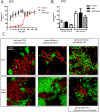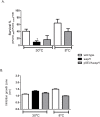Novel role of the LPS core glycosyltransferase WapH for cold adaptation in the Antarctic bacterium Pseudomonas extremaustralis
- PMID: 29415056
- PMCID: PMC5802925
- DOI: 10.1371/journal.pone.0192559
Novel role of the LPS core glycosyltransferase WapH for cold adaptation in the Antarctic bacterium Pseudomonas extremaustralis
Abstract
Psychrotroph microorganisms have developed cellular mechanisms to cope with cold stress. Cell envelopes are key components for bacterial survival. Outer membrane is a constituent of Gram negative bacterial envelopes, consisting of several components, such as lipopolysaccharides (LPS). In this work we investigated the relevance of envelope characteristics for cold adaptation in the Antarctic bacterium Pseudomonas extremaustralis by analyzing a mini Tn5 wapH mutant strain, encoding a core LPS glycosyltransferase. Our results showed that wapH strain is impaired to grow under low temperature but not for cold survival. The mutation in wapH, provoked a strong aggregative phenotype and modifications of envelope nanomechanical properties such as lower flexibility and higher turgor pressure, cell permeability and surface area to volume ratio (S/V). Changes in these characteristics were also observed in the wild type strain grown at different temperatures, showing higher cell flexibility but lower turgor pressure under cold conditions. Cold shock experiments indicated that an acclimation period in the wild type is necessary for cell flexibility and S/V ratio adjustments. Alteration in cell-cell interaction capabilities was observed in wapH strain. Mixed cells of wild type and wapH strains, as well as those of the wild type strain grown at different temperatures, showed a mosaic pattern of aggregation. These results indicate that wapH mutation provoked marked envelope alterations showing that LPS core conservation appears as a novel essential feature for active growth under cold conditions.
Conflict of interest statement
Figures





Similar articles
-
Phosphorylation of lipopolysaccharides in the Antarctic psychrotroph Pseudomonas syringae: a possible role in temperature adaptation.J Bacteriol. 1994 Jul;176(14):4243-9. doi: 10.1128/jb.176.14.4243-4249.1994. J Bacteriol. 1994. PMID: 8021210 Free PMC article.
-
Novel Essential Role of Ethanol Oxidation Genes at Low Temperature Revealed by Transcriptome Analysis in the Antarctic Bacterium Pseudomonas extremaustralis.PLoS One. 2015 Dec 15;10(12):e0145353. doi: 10.1371/journal.pone.0145353. eCollection 2015. PLoS One. 2015. PMID: 26671564 Free PMC article.
-
Polyhydroxyalkanoates are essential for maintenance of redox state in the Antarctic bacterium Pseudomonas sp. 14-3 during low temperature adaptation.Extremophiles. 2009 Jan;13(1):59-66. doi: 10.1007/s00792-008-0197-z. Epub 2008 Oct 18. Extremophiles. 2009. PMID: 18931822
-
The globins of cold-adapted Pseudoalteromonas haloplanktis TAC125: from the structure to the physiological functions.Adv Microb Physiol. 2013;63:329-89. doi: 10.1016/B978-0-12-407693-8.00008-X. Adv Microb Physiol. 2013. PMID: 24054800 Review.
-
Cold-adapted enzymes from marine Antarctic microorganisms.Mar Biotechnol (NY). 2007 May-Jun;9(3):293-304. doi: 10.1007/s10126-006-6103-8. Epub 2006 Dec 29. Mar Biotechnol (NY). 2007. PMID: 17195087 Review.
Cited by
-
Effect of copper on diesel degradation in Pseudomonas extremaustralis.Extremophiles. 2019 Jan;23(1):91-99. doi: 10.1007/s00792-018-1063-2. Epub 2018 Oct 17. Extremophiles. 2019. PMID: 30328541
-
Lipid A structural characterization from the LPS of the Siberian psychro-tolerant Psychrobacter arcticus 273-4 grown at low temperature.Extremophiles. 2018 Nov;22(6):955-963. doi: 10.1007/s00792-018-1051-6. Epub 2018 Aug 20. Extremophiles. 2018. PMID: 30128707
-
Pigment production by cold-adapted bacteria and fungi: colorful tale of cryosphere with wide range applications.Extremophiles. 2020 Jul;24(4):447-473. doi: 10.1007/s00792-020-01180-2. Epub 2020 Jun 1. Extremophiles. 2020. PMID: 32488508 Free PMC article. Review.
-
Reporting Key Features in Cold-Adapted Bacteria.Life (Basel). 2018 Mar 13;8(1):8. doi: 10.3390/life8010008. Life (Basel). 2018. PMID: 29534000 Free PMC article. Review.
-
Snowball Earth, population bottleneck and Prochlorococcus evolution.Proc Biol Sci. 2021 Nov 24;288(1963):20211956. doi: 10.1098/rspb.2021.1956. Epub 2021 Nov 17. Proc Biol Sci. 2021. PMID: 34784770 Free PMC article.
References
-
- Rodrigues DF, Tiedje JM. Coping with our cold planet. Applied and Environmental Microbiology. 2008. pp. 1677–1686. doi: 10.1128/AEM.02000-07 - DOI - PMC - PubMed
-
- Amico SD, Collins T, Marx J, Feller G, Gerday C. Psychrophilic microorganisms: challenges for life. 2006;7: 5–9. doi: 10.1038/sj.embor.7400662 - DOI - PMC - PubMed
-
- Chattopadhyay MK, Raghu G, Sharma YVRK, Biju AR, Rajasekharan M V., Shivaji S. Increase in oxidative stress at low temperature in an antarctic Bacterium. Curr Microbiol. 2011;62: 544–546. doi: 10.1007/s00284-010-9742-y - DOI - PubMed
-
- Godin-Roulling A, Schmidpeter PAM, Schmid FX, Feller G. Functional adaptations of the bacterial chaperone trigger factor to extreme environmental temperatures. Environ Microbiol. 2015;17: 2407–2420. doi: 10.1111/1462-2920.12707 - DOI - PubMed
-
- Tribelli PM, Venero ECS, Ricardi MM, Gómez-Lozano M, Iustman LJR, Molin S, et al. Novel essential role of ethanol oxidation genes at low temperature revealed by transcriptome analysis in the antarctic bacterium pseudomonas extremaustralis. PLoS One. 2015;10 doi: 10.1371/journal.pone.0145353 - DOI - PMC - PubMed
Publication types
MeSH terms
Substances
LinkOut - more resources
Full Text Sources
Other Literature Sources

